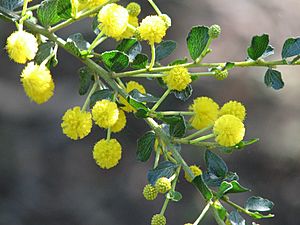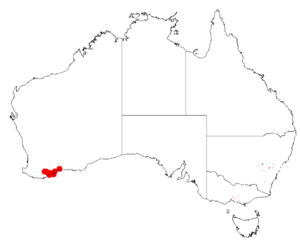Acacia dictyoneura facts for kids
Quick facts for kids Acacia dictyoneura |
|
|---|---|
 |
|
| Scientific classification | |
| Genus: |
Acacia
|
| Species: |
dictyoneura
|
 |
|
| Occurrence data from AVH | |
| Synonyms | |
|
Racosperma dictyoneurum (E.Pritz.) Pedley |
|
Acacia dictyoneura is a type of shrub that belongs to the large group of plants called Acacias. It grows naturally along the south coast of Western Australia.
What it Looks Like
This shrub usually grows to be about 0.5 to 2 meters (about 1.5 to 6.5 feet) tall. It has small branches that are a bit hairy. It also has tiny, triangular leaf-like parts called stipules, which are about 0.5 to 1 millimeter long.
The leaves of this plant are called phyllodes. They are about 6 to 15 millimeters long and 4 to 9 millimeters wide. These leaves stand upright and have an oval or elliptic shape. They have two or three main veins that are slightly raised.
From August to November, you can see bright yellow, round flowerheads on the plant. These flowerheads are about 5 millimeters wide and contain many small flowers, usually between 45 and 60.
After the flowers, the plant forms long, narrow seed pods. These pods are about 3 centimeters long and 4 to 7 millimeters wide. Inside, there are oval-shaped brown seeds, each about 3 millimeters long. They are lined up inside the pod.
How it was Named
This plant was officially described in 1904 by a German botanist named Ernst Pritzel. He studied plant samples collected near Cape Riche.
Later, in 2003, another botanist named Leslie Pedley changed its scientific name to Racosperma dictyoneurum. However, in 2006, it was moved back to the Acacia group. This plant is also closely related to another type of wattle called Acacia awestoniana.
Where it Grows
Acacia dictyoneura is found in the Great Southern area of Western Australia. You can find it between Albany in the west, Gnowangerup in the north, and Ravensthorpe in the east.
It often grows along riverbanks and on gentle slopes. It prefers to grow in loamy soils, which are a mix of sand, silt, and clay. Most of these plants are found near the Pallinup and Fitzgerald Rivers.

